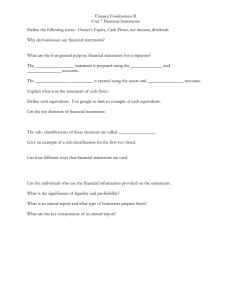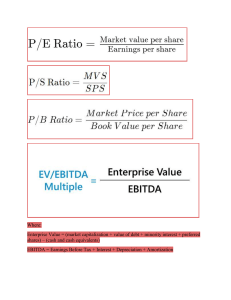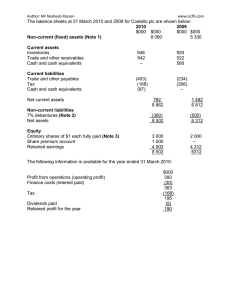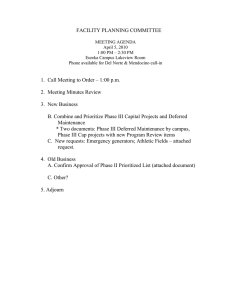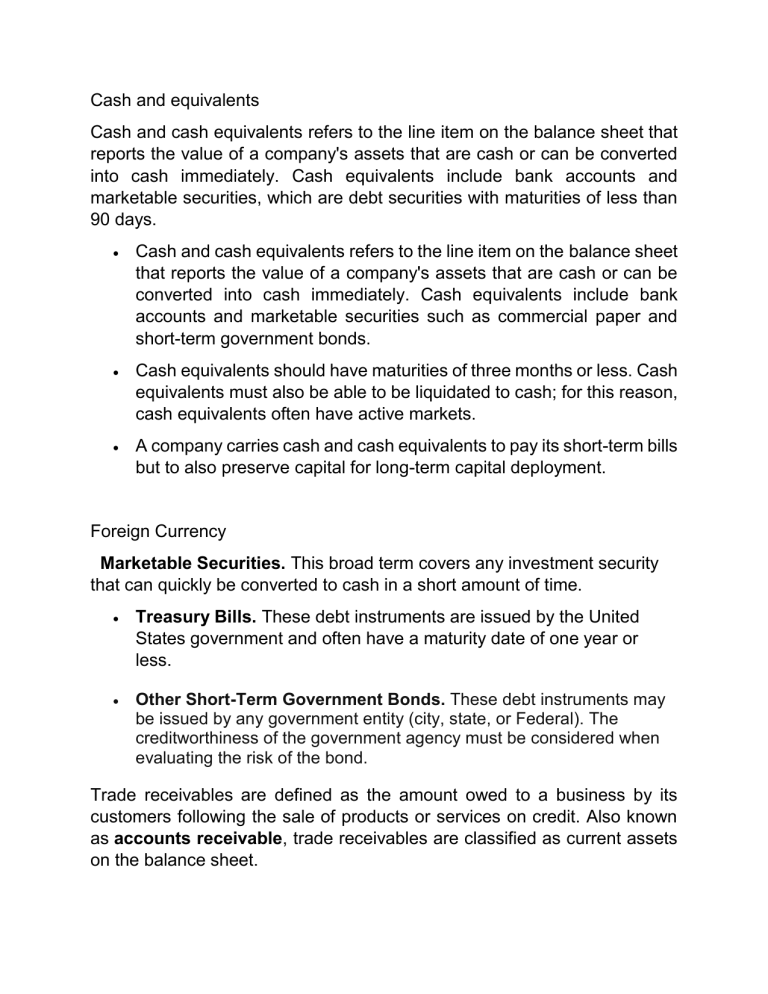
Cash and equivalents Cash and cash equivalents refers to the line item on the balance sheet that reports the value of a company's assets that are cash or can be converted into cash immediately. Cash equivalents include bank accounts and marketable securities, which are debt securities with maturities of less than 90 days. Cash and cash equivalents refers to the line item on the balance sheet that reports the value of a company's assets that are cash or can be converted into cash immediately. Cash equivalents include bank accounts and marketable securities such as commercial paper and short-term government bonds. Cash equivalents should have maturities of three months or less. Cash equivalents must also be able to be liquidated to cash; for this reason, cash equivalents often have active markets. A company carries cash and cash equivalents to pay its short-term bills but to also preserve capital for long-term capital deployment. Foreign Currency Marketable Securities. This broad term covers any investment security that can quickly be converted to cash in a short amount of time. Treasury Bills. These debt instruments are issued by the United States government and often have a maturity date of one year or less. Other Short-Term Government Bonds. These debt instruments may be issued by any government entity (city, state, or Federal). The creditworthiness of the government agency must be considered when evaluating the risk of the bond. Trade receivables are defined as the amount owed to a business by its customers following the sale of products or services on credit. Also known as accounts receivable, trade receivables are classified as current assets on the balance sheet. It isn't uncommon for companies to do business with people and organizations with whom they already have relationships. This kind of business activity is called a related-party transaction. The most common types of related parties are business affiliates, shareholder groups, subsidiaries, and minority-owned companies. Related-party transactions can include sales, leases, service agreements, and loan agreements. As mentioned above, these types of transactions are not necessarily illegal. But they can cloud the business environment by leading to conflicts of interest as they show favorable treatment for close associates of the hiring business. Consider a company that hires a major shareholder's business to renovate its offices. In some cases, related-party transactions must be approved by management consensus or a company’s board of directors. These transactions also limit competition in the marketplace. Prepayment is an accounting term for the settlement of a debt or installment loan in advance of its official due date. A prepayment may be the settlement of a bill, an operating expense, or a non-operating expense that closes an account before its due date. A prepayment may be made by an individual, a corporation, or any other type of organization. A deferred tax asset is an item on a company's balance sheet that reduces its taxable income in the future. Such a line item asset can be found when a business overpays its taxes. This money will eventually be returned to the business in the form of tax relief. Therefore, the overpayment becomes an asset to the company. A deferred tax asset is the opposite of a deferred tax liability, which indicates an expected increase in the amount of income tax owed by a company. Other Payables represents current payables other than Dividends Payable and Income Taxes Payable. These payables are expected to mature within one year or an operating cycle, whichever is longer. Other Payables includes Payables/due to employees, shareholders, officers, directors (other than loans, dividends). Current provisons For example, you can estimate the percentage of customers that are unlikely to pay their bills this year, but you don’t know exactly how much money will be uncollectible. For these expenses, businesses can use what’s called a provision — money set aside to cover specific future financial impacts such as bad debt, taxes and inventory write-downs. Provisions help paint a more accurate picture of a company’s financial situation. Provisions are funds set aside by a business to cover specific anticipated future expenses or other financial impacts. An example of a provision is the estimated loss in value of inventory due to obsolescence. Deferred income is also known as deferred revenue or unearned income. As the name suggests, it refers to income that you have received or not earned yet. Usually, this is because a customer or client has made an advance payment for services that have not yet been rendered or goods that have not yet been delivered. Some key examples include subscription services such as subscription boxes, streaming services or newspapers and magazines. Monthly insurance premiums are also a form of deferred income. If you are a solicitor or paralegal who is on a retainer, this also counts as a form of deferred income. Likewise, any time a creative service is engaged and a down payment made in advance, this must also be classed as deferred income. money that a company has already raised from shareholders: Share premium is the excess money received for issued shares above the par value. The share premium account is a reserve account whose funds can only be used for purposes provided in the corporate bylaws, such as for share issue costs or issuance of bonus shares, but cannot be used for dividends. A restricted fund is a reserve account that contains money that can be used only for specific purposes. Restricted funds provide reassurance to donors that their contributions are used in a manner that they have chosen. They most often appear in the context of funds held by certain nonprofits, universities, or insurance companies. A restricted fund is any cash balance that has been earmarked for specific or limited use. Often associated with funds held by donations To nonprofit organizations or endowments, restricted funds ensure that donors alone can direct the usage of those assets. Failure to comply with restrictions or unauthorized use of restricted funds can result in legal action. The cost of sales is the accumulated total of all costs used to create a product or service, which has been sold. The cost of sales is a key part of the performance metrics of a company, since it measures the ability of an entity to design, source, and manufacture goods at a reasonable cost. The term is most commonly used by retailers. Gross profit is the profit a company makes after deducting the costs associated with producing and selling its products or the costs associated with its services. Gross profit may also be referred to as sales profit or gross income. Gross profit, also called gross income, is calculated by subtracting the cost of goods sold from revenue. Gross profit commonly includes variable costs and not fixed costs. A deferred tax liability is a listing on a company's balance sheet that records taxes that are owed but are not due to be paid until a future date. An installment sale is one of several possible approaches to revenue recognition under the rules of Generally Accepted Accounting Principles (GAAP). More specifically, this method accounts for when revenue and expense are recognized at the time of cash collection rather than at the time of sale. Earnings per share (EPS) is calculated as a company's profit divided by the outstanding shares of its common stock. The resulting number serves as an indicator of a company's profitability. Diluted EPS is a financial ratio that shows how much profit a company generates for each share of its stock. Diluted EPS can be used to compare the profitability of different companies or to assess the financial performance of a company over time.

